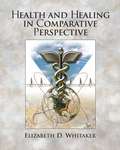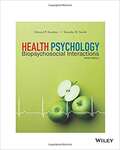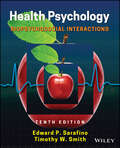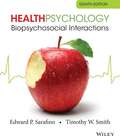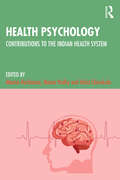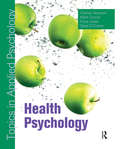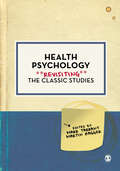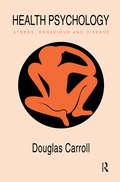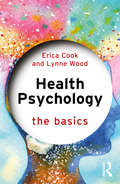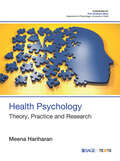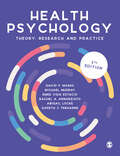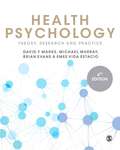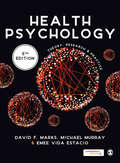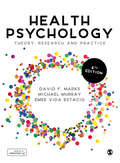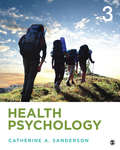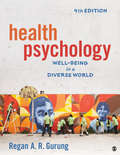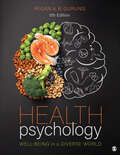- Table View
- List View
Health Psychology: An Interdisciplinary Approach to Health, CourseSmart eTextbook
by Elizabeth D. WhitakerThis reader looks at both the biological and cultural aspects of health and healing within a comparative framework. Health and Healing in Comparative Perspective provides both fascinating comparative ethnographic detail and a theoretical framework for organizing and interpreting information about health. While there are many health-related fields represented in this book, its core discipline is medical anthropology and its main focus is the comparative approach. Cross-cultural comparison gives anthropological analysis breadth while the evolutionary time scale gives it depth. These two features have always been fundamental to anthropology and continue to distinguish it among the social sciences. A third feature is the in-depth knowledge of culture produced by anthropological methods such as participant-observation, involving long-term presence in and research among a study population. For medical anthropology, medical sociology, public health, nursing courses.
Health Psychology: An Introduction to Behavior and Health Eighth Edition
by Jess Feist Linda Brannon John A. UpdegraffFor over 20 years, HEALTH PSYCHOLOGY: AN INTRODUCTION TO BEHAVIOR AND HEALTH has remained a leader in the field of health psychology for its scholarship, strong and current research base, and balanced coverage of the cognitive, behavioral, and biological approaches to health psychology.
Health Psychology: Biopsychosocial Interactions
by Edward P. Sarafino Timothy W. SmithEd Sarafino and Timothy Smith draw from the research and theory of multiple disciplines in order to effectively demonstrate how psychology and health impact each other. The newly updated 9th Edition of Health Psychology: Biopsychsocial Interactions includes a broader picture of health psychology by presenting cross-cultural data. Furthermore, international examples are also included to further explore the psychologists perspective of health issues around the world and highlight what works in the field. The psychological research cited in the text supports a variety of behavioral, physiological, cognitive, and social/personality viewpoints. An emphasis on lifespan development in health and illness is integrated throughout the text.
Health Psychology: Biopsychosocial Interactions
by Edward P. Sarafino Timothy W. SmithIn the newly revised 10th edition of Health Psychology: Biopsychosocial Interactions, a team of dedicated psychologists delivers an insightful and multidisciplinary demonstration of the impact of psychology and health on one another. Relying heavily on cross-cultural data, the book offers a sweeping and inclusive picture of health psychology and includes local and global research and case studies. <P><P> The authors have included boxed materials in each chapter that directs the reader’s attention to the right information at the right time. Behavioral, physiological, cognitive, and social/personality viewpoints are addressed throughout the text and a strong focus on lifespan development in health and illness pervades the material.
Health Psychology: Biopsychosocial Interactions (8th Edition)
by Edward P. Sarafino Timothy W. SmithSarafino draws from the research and theory of many disciplines in order to show psychologists how psychology and health affect each other.
Health Psychology: Contributions to the Indian Health System
by Meena Hariharan Meera Padhy Usha ChivukulaThis book provides a holistic understanding of the state of health psychology in the Indian context and the types of psychological and social support and welfare that are offered and required within treatment processes for various illnesses. The book discusses why health care should be the prerogative of both the biomedical profession and health psychologists and how they work together with medical professionals to augment public health. It emphasises the shift from biomedical to biopsychosocial approach in strengthening health care outcomes. The book highlights the substantial contribution of health psychology to the Indian health care system through simple, cost-effective, indigenous, and standardised techniques that worked efficiently in the context of various diseases. It projects the emerging trends and innovative techniques in health psychology in handling challenging health care needs. This book will be of interest to students, teachers, and researchers of psychology, psychiatry, social psychology, sociology, social work and South Asian studies.
Health Psychology: Critical Concepts In Psychology (Topics in Applied Psychology)
by Charles AbrahamTopics in Applied Psychology offers a range of accessible, integrated texts ideal for courses in applied psychology. The books are written by leading figures in their field and provide a comprehensive academic and professional insight into each topic. They incorporate a range of features to bring psychology to life including case histories, research methods, ethical debate and learner activities. Each chapter opens with learning objectives to consolidate key points. A reading list and sample essay questions at the end of chapters enable further independent study. The series also offers an appreciation of multiple perspectives, examines the relationship between psychology and other cognate disciplines and discusses recent developments in each field. Topics in Applied Psychology will provide you with the tools you need to engage with, enjoy and understand your applied psychology discipline, ultimately ensuring confidence and success in exams as well as a comprehensive grounding in the profession. Health Psychology guides the reader through core issues in health psychology research and practice. Each chapter builds on previous ones so that the text provides an overview of the field rather than presenting a compendium of topics. The book discusses mechanisms, models and methods and examines how biological, cognitive, affective and social processes impact on health and illness. It also explores how stress and coping mechanisms affect health behaviours and the psychological determinants of health behaviour. Two chapters focus on how psychological research can be applied to change health-related attitudes and behaviours. Communication between the patient and practitioner is examined as is the role of the health psychologist. The integrated and interactive approach, combined with the comprehensive coverage, make this book the ideal companion for courses in health psychology.Other books in the series include: Clinical Psychology, Criminal Psychology, Educational Psychology, Organizational and Work Psychology and Sport and Exercise Psychology.
Health Psychology: Revisiting the Classic Studies (Psychology: Revisiting the Classic Studies)
by Martin S. Hagger Mark TarrantHealth Psychology: Revisiting the Classic Studies reflects and expands upon 13 of the most innovative contributions to the field from researchers such as Friedman and Rosenman, Marmot, Kiecolt-Glaser, and Ajzen. This book will familiarise you with the classic studies, spanning a period from the 1950s to 2010s, and show you how they continue to apply to the world today. Revisiting the Classic Studies is a series of texts that introduces readers to the studies in psychology that changed the way we think about core topics in the discipline today. It provokes students to ask more interesting and challenging questions about the field by encouraging a deeper level of engagement both with the details of the studies themselves and with the nature of their contribution. Edited by leading scholars in their field and written by researchers at the cutting edge of these developments, the chapters in each text provide details of the original works and their theoretical and empirical impact, and then discuss the ways in which thinking and research have advanced in the years since the studies were conducted. Mark Tarrant is Professor at the University of Plymouth Martin S. Hagger is Professor at the University of California, Merced and Finland Distinguished Professor (FiDiPro) at University of Jyväskylä.
Health Psychology: Revisiting the Classic Studies (Psychology: Revisiting the Classic Studies)
by Martin S. Hagger Mark TarrantHealth Psychology: Revisiting the Classic Studies reflects and expands upon 13 of the most innovative contributions to the field from researchers such as Friedman and Rosenman, Marmot, Kiecolt-Glaser, and Ajzen. This book will familiarise you with the classic studies, spanning a period from the 1950s to 2010s, and show you how they continue to apply to the world today. Revisiting the Classic Studies is a series of texts that introduces readers to the studies in psychology that changed the way we think about core topics in the discipline today. It provokes students to ask more interesting and challenging questions about the field by encouraging a deeper level of engagement both with the details of the studies themselves and with the nature of their contribution. Edited by leading scholars in their field and written by researchers at the cutting edge of these developments, the chapters in each text provide details of the original works and their theoretical and empirical impact, and then discuss the ways in which thinking and research have advanced in the years since the studies were conducted. Mark Tarrant is Professor at the University of Plymouth Martin S. Hagger is Professor at the University of California, Merced and Finland Distinguished Professor (FiDiPro) at University of Jyväskylä.
Health Psychology: Stress, Behaviour And Disease (Contemporary Psychology Ser. #Vol. 4)
by Douglas CarrollThis work, designed for A-Level and undergraduate students, describes how behaviour can interact with stress to produce ill-health and, conversely, how stress can be managed to avoid the dangers of heart disease and other illnesses. Health psychology has a relatively short history, but the past decade has witnessed an explosion of interest in this topic. It is designed to be accessible to the beginning psychology student but to take that student, or any other interested reader, to a depth sufficient to enable them to feel a sense of satisfaction in being able to co me to grips with the major theoretical and empirical perspectives that are influential in contemporary psychology. Professor Carroll has, himself, a distinguished record of research in health psychology and his own research and writing has substantially influenced the development of this field in Britain..
Health Psychology: The Basics (The Basics)
by Erica Cook Lynne WoodThis accessible primer on health psychology covers the key theories and models of the discipline. Through the use of real-life case studies and examples, it covers a broad range of topics related to the field of health psychology including: health promotion, risky health behaviour and health in healthcare settings. It explains how health psychology serves to not only promote positive health and reduce maladaptive health behaviours, but also support those who are chronically ill. Unlike medicine, health psychology takes a more holistic approach through the interaction of psychological, social and biological factors to improve health. This book outlines the inter-relationship between how we think and feel, our biological systems and the social contexts in which we live. It discusses how belief and attitude can shape behavior, the pivotal role of stress and how we can adjust to chronic illness. Drawing from experience, the authors answer important and common questions like how can we stop people from smoking? Does stress really make us ill? Why don't people take their medication as prescribed? And how can we support people to adjust to a chronic health condition? It also provides a unique focus on children and adolescent health which considers how developmental changes impact health behaviours and subsequent health. It is an essential introductory text suitable for students, professionals and general readers interested in this important and emerging topic area. It also provides useful information for those interested in working in the field by providing an overview of what health psychologists do, where they work and the pathways available to become a registered health psychologist.
Health Psychology: Theory, Practice and Research
by Meena HariharanIt is a textbook meant for the students of UG and PG courses in Psychology. Satisfying a long-standing need for an approachable textbook that brings together the Western and Indian perspective on health psychology, this book coherently presents the knowledge diversified across various narrow sub-fields. Each chapter is illustrated with engaging diagrams, real-life examples and recent research studies to make the content easy to understand as well as application-oriented. Dedicated text boxes for practitioners and researchers in the area are expected to stimulate students to think innovatively along culturally relevant lines and take steps towards meaningful research. Health Psychology: Theory, Practice and Research will prove to be an indispensable companion for students of undergraduate and postgraduate levels, researchers and practitioners in psychology, as well as for medical and paramedical studies. Key Features: • Enriched with real-life cases, engaging illustrations and citations from major research studies • Insights into culturally relevant problems and interventions • Identification of research design and practitioner's action points for every theme • Self-explanatory and student-friendly treatment of topics, following curriculum guidelines of major Indian universities
Health Psychology: Theory, Research and Practice
by Michael Murray David F. Marks Emee Vida Estacio Gareth J. Treharne Abigail Locke Rachel A. AnnunziatoHealth Psychology takes a truly international and critical biopsychosocial approach, providing students with a holistic understanding of health behaviour, culture and change. Thoroughly updated with the latest research, this comprehensive introduction to foundational and cutting-edge topics in health psychology gives you the tools you need to critically appraise theory and research, and to apply this knowledge to real-world public health issues. Praised for its coverage of social justice, macro-social and cultural issues in health, this edition features three new chapters on parenting and health, responses to the COVID-19 pandemic, and gender-affirmative healthcare for transgender people. Now in full colour, it also includes updated pedagogy, with international Key Studies, Critical Discussions and Insights boxes to extend your learning. Written by experts in the field, this must-read for students of Health Psychology, Health Promotion and Health Behaviour demonstrates how theory and research learned in the classroom impacts public policy around the world. David F. Marks is a psychologist specializing in Health Psychology, Mental Imagery and Consciousness research. Michael Murray is Emeritus Professor of Social and Health Psychology at Keele University. Emee Vida Estacio is a chartered psychologist, author, speaker and health promotion specialist. Rachel A. Annunziato is Professor of Psychology at Fordham University. Abigail Locke is Professor of Critical Social and Health Psychology and Head of School at Keele University. Gareth J. Treharne is Professor of Psychology at te Whare Wananga o Otago (the University of Otago).
Health Psychology: Theory, Research and Practice
by Michael Murray David F. Marks Emee Vida Estacio Gareth J. Treharne Abigail Locke Rachel A. AnnunziatoHealth Psychology takes a truly international and critical biopsychosocial approach, providing students with a holistic understanding of health behaviour, culture and change. Thoroughly updated with the latest research, this comprehensive introduction to foundational and cutting-edge topics in health psychology gives you the tools you need to critically appraise theory and research, and to apply this knowledge to real-world public health issues. Praised for its coverage of social justice, macro-social and cultural issues in health, this edition features three new chapters on parenting and health, responses to the COVID-19 pandemic, and gender-affirmative healthcare for transgender people. Now in full colour, it also includes updated pedagogy, with international Key Studies, Critical Discussions and Insights boxes to extend your learning. Written by experts in the field, this must-read for students of Health Psychology, Health Promotion and Health Behaviour demonstrates how theory and research learned in the classroom impacts public policy around the world. David F. Marks is a psychologist specializing in Health Psychology, Mental Imagery and Consciousness research. Michael Murray is Emeritus Professor of Social and Health Psychology at Keele University. Emee Vida Estacio is a chartered psychologist, author, speaker and health promotion specialist. Rachel A. Annunziato is Professor of Psychology at Fordham University. Abigail Locke is Professor of Critical Social and Health Psychology and Head of School at Keele University. Gareth J. Treharne is Professor of Psychology at te Whare Wananga o Otago (the University of Otago).
Health Psychology: Theory, Research and Practice
by Michael Murray David F. Marks Brian Evans Emee Vida EstacioHealth Psychology students will need to understand how to evaluate and critically-appraise the latest theory and research before it can be applied. This fully-revised and updated fourth edition takes a critical approach and places Health Psychology in a real-world context, enabling students to understand how public policy, theory and research can influence communities and individuals alike. The new edition includes: A new chapter on diet and obesity Updated material on stress and coping, doctor-patient communication, death, dying, bereavement and quality of life Introductions to the social, political and economic conditions that influence our health Breadth of coverage from social inequality through to chronic illness and screening An enhanced SAGE edge™ companion website (edge.sagepub.com/marks4e) with a suite of features to enhance students' learning experience.
Health Psychology: Theory, Research and Practice
by Michael Murray David F. Marks Brian Evans Emee Vida EstacioHealth Psychology students will need to understand how to evaluate and critically-appraise the latest theory and research before it can be applied. This fully-revised and updated fourth edition takes a critical approach and places Health Psychology in a real-world context, enabling students to understand how public policy, theory and research can influence communities and individuals alike. The new edition includes: A new chapter on diet and obesity Updated material on stress and coping, doctor-patient communication, death, dying, bereavement and quality of life Introductions to the social, political and economic conditions that influence our health Breadth of coverage from social inequality through to chronic illness and screening An enhanced SAGE edgeTM companion website (edge.sagepub.com/marks4e) with a suite of features to enhance students' learning experience.
Health Psychology: Theory, Research and Practice
by Michael Murray David F. Marks Emee Vida EstacioHealth psychology students will need to understand how to evaluate and critically-appraise the latest theory and research before it can be applied. This fully-revised and updated Fifth Edition takes a critical approach and places health psychology in a real-world context, enabling students to understand how public policy, theory and research can influence communities and individuals alike. The new Fifth Edition includes: 9 new and expanded chapters Updated material on stress and coping, doctor-patient communication, death, dying, bereavement and quality of life Introductions to the social, political and economic conditions that influence our health Breadth of coverage from social inequality through to chronic illness and screening This book also comes with access to fantastic online resources including multiple choice quizzes, case studies, test banks and slides. If you want to link all these resources right in your university’s learning management system, ask your sales rep about SAGE course cartridges.
Health Psychology: Theory, Research and Practice
by Michael Murray David F. Marks Emee Vida EstacioHealth psychology students will need to understand how to evaluate and critically-appraise the latest theory and research before it can be applied. This fully-revised and updated Fifth Edition takes a critical approach and places health psychology in a real-world context, enabling students to understand how public policy, theory and research can influence communities and individuals alike. The new Fifth Edition includes: 9 new and expanded chapters Updated material on stress and coping, doctor-patient communication, death, dying, bereavement and quality of life Introductions to the social, political and economic conditions that influence our health Breadth of coverage from social inequality through to chronic illness and screening This book also comes with access to fantastic online resources including multiple choice quizzes, case studies, test banks and slides. If you want to link all these resources right in your university’s learning management system, ask your sales rep about SAGE course cartridges.
Health Psychology: Theory, Research and Practice
by Michael Murray David F. Marks Emee Vida EstacioHealth Psychology provides students with the tools they need to evaluate and critically appraise theory and research before it can be applied practically. Using the most up-to-date research available, the sixth edition places an emphasis on the real-world application of health psychology, demonstrating how theory learnt in the classroom influences public policy. In this book, David Marks, Michael Murray and Emee Vida Estacio take a holistic approach to health psychology, giving equal weight to the biological, psychological and social factors that impact health behaviour, culture and change. The text presents students with an accessible and comprehensive introduction to the field of health psychology and is supported by online resources for students and lecturers, including a range of case studies taken from across the world.
Health Psychology: Theory, Research and Practice
by Michael Murray David F. Marks Emee Vida EstacioHealth Psychology provides students with the tools they need to evaluate and critically appraise theory and research before it can be applied practically. Using the most up-to-date research available, the sixth edition places an emphasis on the real-world application of health psychology, demonstrating how theory learnt in the classroom influences public policy. In this book, David Marks, Michael Murray and Emee Vida Estacio take a holistic approach to health psychology, giving equal weight to the biological, psychological and social factors that impact health behaviour, culture and change. The text presents students with an accessible and comprehensive introduction to the field of health psychology and is supported by online resources for students and lecturers, including a range of case studies taken from across the world.
Health Psychology: Understanding the Mind-Body Connection
by Catherine A. SandersonHealth Psychology: Understanding the Mind-Body Connection introduces students to the story of health psychology through clear connections between the science and the real world. Using a highly accessible writing style, author Catherine A. Sanderson employs a strong emphasis on the scientific principles and processes underlying the field of health psychology to present balanced coverage of foundational research, cutting-edge research, essential theories, and real-world application. The Third Edition builds on its strong student-oriented pedagogical program, streamlines content, and includes recent studies, pop culture references, and coverage of neuroscience to support student learning and engagement. Students will enjoy reading the text because of its relevance in helping them live long and healthy lives.
Health Psychology: Understanding the Mind-Body Connection
by Catherine A. SandersonHealth Psychology: Understanding the Mind-Body Connection introduces students to the story of health psychology through clear connections between the science and the real world. Using a highly accessible writing style, author Catherine A. Sanderson employs a strong emphasis on the scientific principles and processes underlying the field of health psychology to present balanced coverage of foundational research, cutting-edge research, essential theories, and real-world application. The Third Edition builds on its strong student-oriented pedagogical program, streamlines content, and includes recent studies, pop culture references, and coverage of neuroscience to support student learning and engagement. Students will enjoy reading the text because of its relevance in helping them live long and healthy lives.
Health Psychology: Well-Being in a Diverse World
by Regan A. GurungHealth Psychology: Well-Being in a Diverse World introduces students to the main topics and issues in health psychology through a unique perspective focused on diversity. Using a conversational tone, author A. R. Gurung explores the key determinants of behavior—such as family, environment, ethnicity, and religion—and connects concepts to personal experiences for students to gain a deeper understanding and appreciation of the material. Extensively updated based on over 1,000 new articles cited, and with a new chapter on research methods, the Fourth Edition reflects the latest cutting-edge research in the field to explain more thoroughly how context and culture are important predictors of healthy behavior.
Health Psychology: Well-Being in a Diverse World
by Regan A. GurungHealth Psychology: Well-Being in a Diverse World introduces students to the main topics and issues in health psychology through a unique perspective focused on diversity. Using a conversational tone, author A. R. Gurung explores the key determinants of behavior—such as family, environment, ethnicity, and religion—and connects concepts to personal experiences for students to gain a deeper understanding and appreciation of the material. Extensively updated based on over 1,000 new articles cited, and with a new chapter on research methods, the Fourth Edition reflects the latest cutting-edge research in the field to explain more thoroughly how context and culture are important predictors of healthy behavior.
Health Psychology: Well-Being in a Diverse World
by Regan A. R. GurungWhat factors determine healthy behavior? Health Psychology: Well-Being in a Diverse World answers this question by introducing and regularly applying research to stress, coping, interventions and health behaviors in today’s world. Speaking directly to students, Regan A. R. Gurung’s conversational voice guides learners through the key determinants of behavior, such as family, environment, ethnicity, and religion. Each chapter delves into the biological foundations of health, presents interdisciplinary case studies, and integrates personality and social psychological theories, fostering a comprehensive grasp of the subject. Continually asking readers to think further, to synthesize, to analyze, and to apply to improve their own health outcomes as they learn, Gurung empowers students through connections to personal experience. The Fifth Edition offers contemporary reference updates, an expanded focus on intersectional topics across cultures, test yourself practice, and much more. This title is accompanied by a complete teaching and learning package. Contact your Sage representative to request a demo. Learning Platform / Courseware Sage Vantage is an intuitive learning platform that integrates quality Sage textbook content with assignable multimedia activities and auto-graded assessments to drive student engagement and ensure accountability. Unparalleled in its ease of use and built for dynamic teaching and learning, Vantage offers customizable LMS integration and best-in-class support. It′s a learning platform you, and your students, will actually love. Learn more. LMS Cartridge: Import this title’s instructor resources into your school’s learning management system (LMS) and save time. Don’t use an LMS? You can still access all of the same online resources for this title via the password-protected Instructor Resource Site. Learn more.
